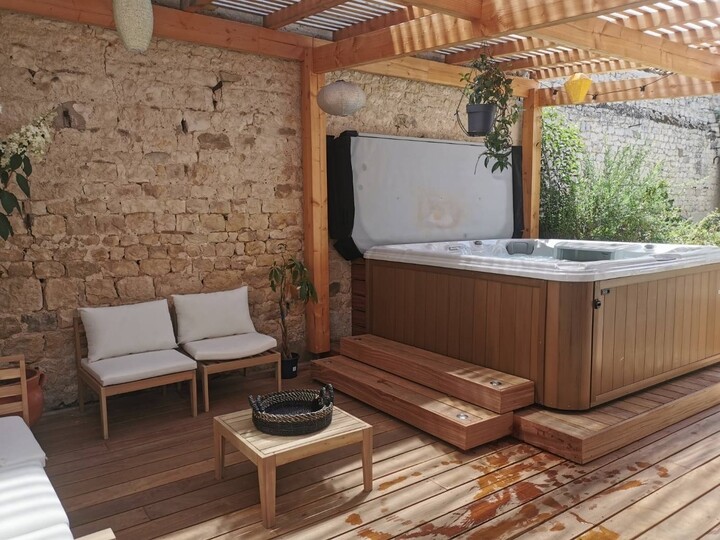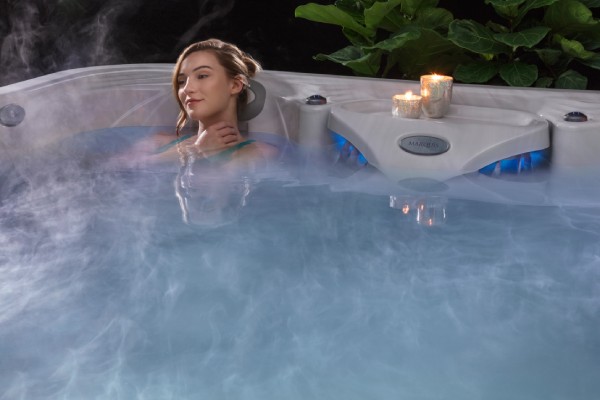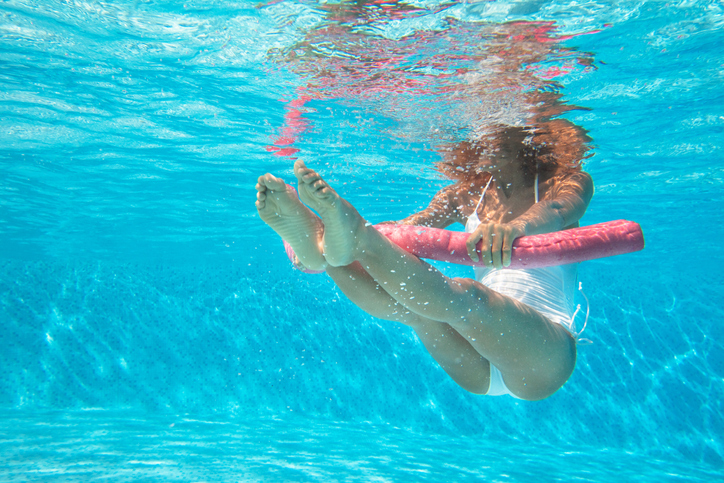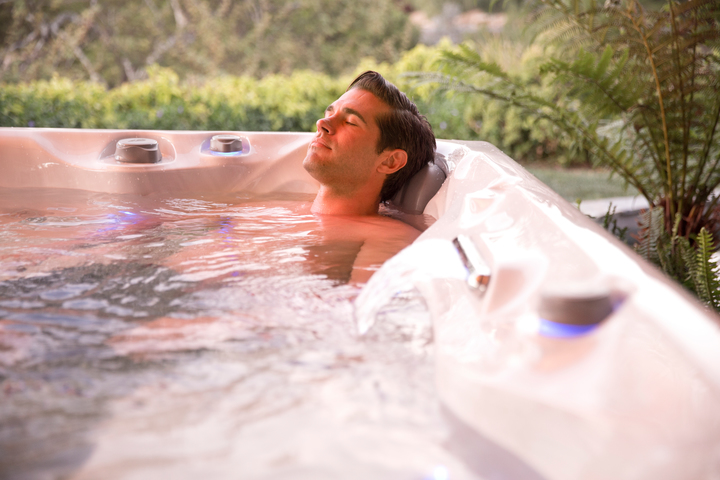Have you ever wondered what it takes to keep hot tub water crystal clear, even when it’s being used every day?
Maybe you’re in the market for a hot tub and want to be prepared before delivery day, or perhaps your water has been difficult to manage lately, and you want to freshen up your hot tub chemical knowledge.
Whatever the case, you’ve come to the right place.
This article will have everything you need to know, from the best chemicals to keep in your arsenal, how to use them, and even tips on how to keep your water clean to minimize the amount of chemicals you’ll need to use.
Let’s jump in.
6 Hot Tub Chemicals for a Clean Hot Tub
Using the right chemicals in your maintenance routine will help ensure your water is crystal clear and safe to use each time you lift the cover to enjoy a quality soak.
Before adding any chemicals to your water, you’ll need to test it to accurately determine what chemicals you need to use each time and how much you need to add.
We recommend quickly testing your water before any soak, but at the very least, you should be testing your water twice a week.
After you know where your levels are sitting, you can add your chemicals as needed.
Here are six hot tub chemicals you should keep on hand and how often you can expect to use them.
1. pH and Alkalinity Treatments
Your water has two very important aspects that you’ll need to keep in proper balance to ensure your water is safe to use and not causing damage to your system; pH and alkalinity.
pH is a measurement of how acidic your water is, while alkalinity is your water’s ability to maintain the optimum levels of your pH.
A low pH level means your water is too acidic.
Acidic water can become corrosive to your system, slowly eating away at its components and causing long-term damage that can lead to costly repairs in the future.
High pH can result in scale forming, which also damages your system and can lead to clogs forming in your pipes or an ineffective heater that’s working twice as hard to maintain your water temperature due to the scale buildup on it.
So, what are the right pH and alkalinity levels for your hot tub water?
Your alkalinity should always remain between 80 and 120 ppm (parts-per-million), whereas your pH should be between 7.2 and 7.8.
Your pH and alkalinity chemicals will mostly be used when you do a water change as you rebalance your fresh water.
To maintain these levels, you’ll need to include:
- pH increaser
- pH decreaser
- Total alkalinity increaser
Where your levels are when you test your water will determine which ones you’ll need to use.
You should ALWAYS treat your alkalinity first before adding any pH treatments.
This is because your alkalinity will have a large influence over your pH levels, so you’ll want to balance them first before trying to adjust your pH.
For example, if your pH and alkalinity are too low, you’ll want to treat your water with the total alkalinity increaser first to bring it into range, then follow it up with your pH treatment as needed.
Frequency: As needed depending on the results of your water test.
2. Sanitizer
Your sanitizer is the chemical that combats any bacteria that build up in your water.
Hot water is the perfect environment for bacteria and germs to thrive, so keeping your sanitizer levels in check is essential to clean and safe water.
There are many types of sanitizers on the market, with chlorine being the most popular option by far and bromine being the second most common selection.
Chlorine is affordable and highly effective in keeping your water clean and easy to use.
If using chlorine, you’ll want to ensure your sanitizer levels are between 1 and 3 ppm.
Bromine, on the other hand, is slightly more costly and breaks down faster under the harsh UV rays of the sun.
However, it offers a smoother soaking experience, which is one of the reasons many people have chosen to use it.
If you’re using bromine, you’ll want to maintain sanitizer levels of 3 – 5 ppm.
Frequency: After each use as needed, or a few times a week after testing your water to verify your sanitizer levels need a boost.
3. Shock
Shock is an essential part of your water care and directly supports your sanitizer.
Non-chlorine oxidizing shock is one of the most popular options, and for good reason.
While your sanitizer is effective at breaking down bacteria and keeping your water clean, there are certain contaminants it’s unable to properly combat, such as oils from hair products or deodorants.
Shock treatment targets these contaminants instead, breaking them down and allowing your sanitizer to do its job more effectively.
Some signs you might need to shock your water include:
- Cloudy water
- Foam
- Algae blooms
Frequency: Generally, adding shock to your hot tub once a week will be more than enough to maintain the clarity of your water.
4. Calcium Hardness Increaser
As mentioned above, the quality of your water is an important factor in a clean and safe soaking experience.
Everyone’s water quality will vary based on their local water supply, and while some people naturally have hard water (often distinguished by calcium deposits building up on faucets), others may have water that’s particularly soft.
Calcium is an essential aspect of your water, and if there isn’t enough, it can be difficult to balance your pH and alkalinity, especially after a water change.
Calcium hardness is a great solution to this.
If you have soft water, adding this to your spa will help boost the mineral levels in your water, making it easier to balance.
If you need to include a calcium hardness increaser in your routine, be careful when adding it.
While it’s necessary to balance your water, adding too much will result in scale forming and your other chemicals not working as effectively.
Add small amounts at a time and keep testing your water between treatments to ensure you don’t go over.
Your calcium hardness level should be kept between 175 and 250 ppm
Frequency: You’ll typically only treat your water with a calcium hardness increaser directly after a water change to make balancing your pH and alkalinity easier.
5. Clarifier
This hot tub chemical is worth having on standby but shouldn’t be included in your regular routine.
Clarifier is a hot tub chemical that is specifically used to bring clarity to your water but only for a short period of time.
For example, if you lift your cover and discover cloudy or foamy water and need a quick fix, a clarifier is the answer.
However, if you don’t determine the root cause of the dirty water, it’ll come back shortly after, so this is best used only if you need your hot tub right away and don’t have the time to diagnose the issue.
Frequency: Only when you absolutely need to clear up your water quickly and don’t have time to diagnose the root cause of your dirty water.
6. Filter Cleaner
While filter cleaner isn’t technically a hot tub chemical you’ll be adding to your spa, it supports the overall function of your system and water health.
Cleaning your filters is essential to maintaining clean and clear water, and a filter cleaner is a necessary chemical to include in your cleaning routine.
Each month, you’ll want to spray your hot tub filters with filter cleaner.
This will help loosen up any stubborn debris they’ve collected over the month, leaving you with clean filters that can easily maintain your water.
Frequency: Once a month.
How to Add Chemicals to Your Hot Tub
Having all the right hot tub chemicals is a great starting point, but knowing how to add them to your water, is equally as important.
How you add them can have a significant impact on your water, so it’s important to do it right.
For example, if you add your sanitizer and close your cover right away, you’re trapping in any of the gas that’s produced as it treats your water, raising your chemical levels higher than you expected.
To add your chemicals to your water, you’ll want to follow these seven steps.
- Test your water with your pH test strips or digital meter
- Turn your jets on and close your air valves
- Measure your chemicals (twice for accuracy)
- Add chemicals to your water
- Leave the cover off and let your hot tub run for 30 minutes
- Retest your water
- Rinse and repeat as necessary
Easy Tips to Keep Your Hot Tub Water Clean
If you want to make maintaining your water even easier and reduce the amount of hot tub chemicals you need to add to it, there are a few easy steps that can help.
- Shower before each soak
- Keep your hair up
- Use hot tub sponges or tennis balls
- Maintain a well-planned routine
- Schedule professional service
Showering and keeping your hair up when you’re in your spa will help reduce the oils that contaminate your water, lowering the amount of shock and sanitizer you may need to add to your water.
Adding hot tub sponges or tennis balls to your water after you’re done in your spa will help absorb any of the oils that did make it into your water.
Following a quality maintenance schedule and including professional service in your routine will help reduce the risk of your water falling out of balance, make maintenance easier, and ensure small issues are caught early on before they begin causing larger problems with your hot tub.
Try including some or all of these steps in your routine, and see how big of a difference they can make.
Hot Tub Chemicals for Sale in New Jersey
Whether you’re looking to restock all your essential hot tub chemicals or need to find the perfect ones to treat your water once your new hot tub is delivered, National Pools & Spas can help.
With four convenient locations throughout New Jersey, including Flemington, Hillsborough, Lawrenceville, and Robbinsville, our team of experts can easily help you find everything you need.
Visit your local showroom to find all your hot tub chemicals, or contact us, and we’ll be happy to assist you in any way we can.





